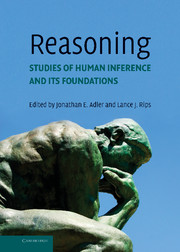16 - Reasoning in Conceptual Spaces
Published online by Cambridge University Press: 05 June 2012
Summary
Three levels of modeling reasoning
Processes of reasoning have been at the heart of analysis in analytic philosophy, artificial intelligence (AI) and in the early development of cognitive science. In these traditions, reasoning has been modeled as operations on propositions that are expressed by symbolic structures. I will call this approach the symbolic paradigm.
The central tenet of the symbolic paradigm is that representing and processing information essentially consists of symbol manipulation according to explicit rules. For example, Pylyshyn (1984: 29) writes: “[T]o be in a certain representational state is to have a certain symbolic expression in some part of memory.” The symbols can be concatenated to form expressions in a language of thought (Fodor 1975), which is sometimes called Mentalese. The content of a sentence in Mentalese is a belief or a thought of an agent. The different beliefs in the cognitive states of a person are connected via their logical or inferential relations. Thus, the manipulations of symbols are performed without considering the semantic content of the symbols. In applications within AI, first-order logic has been the dominating inferential system (or some related programming version of it, such as Prolog). But in other areas more general forms of inference, like those provided by inductive logic or decision theory, have been utilized.
The symbols are used for modeling logical inferences and the expressions represent propositions, which stand in various logical relations to each other. Information processing involves above all computations of logical consequences.
Information
- Type
- Chapter
- Information
- ReasoningStudies of Human Inference and its Foundations, pp. 302 - 320Publisher: Cambridge University PressPrint publication year: 2008
References
Accessibility standard: Unknown
Why this information is here
This section outlines the accessibility features of this content - including support for screen readers, full keyboard navigation and high-contrast display options. This may not be relevant for you.Accessibility Information
- 2
- Cited by
